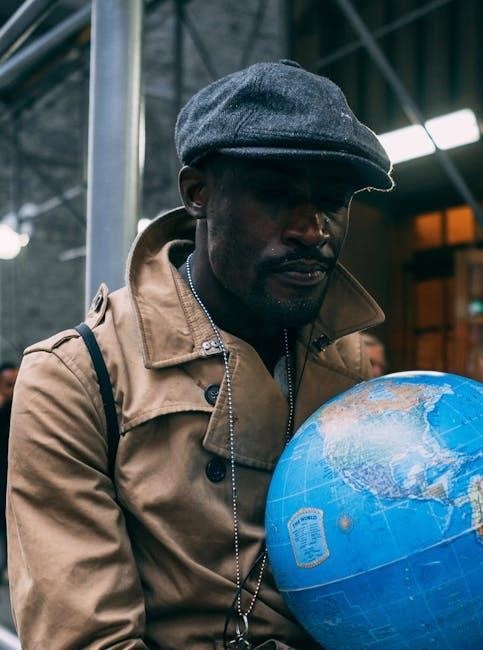Overview of “Between the World and Me”
Ta-Nehisi Coates’s “Between the World and Me” is a powerful letter to his son‚ Samori‚ exploring the realities of being Black in America. The book spans personal experiences‚ national history‚ and social commentary‚ offering a profound analysis of race and identity.
“Between the World and Me” takes the form of a letter from Ta-Nehisi Coates to his teenage son‚ Samori. In this letter‚ Coates attempts to articulate the experience of being Black in America‚ drawing on his own life and observations. He recounts his upbringing in Baltimore‚ his intellectual awakening at Howard University‚ and his ongoing struggle to understand and navigate a society marked by racial injustice.
Coates shares his fears for his son’s safety and well-being in a world where Black bodies are systematically devalued and threatened. He critiques the “Dream‚” the idealized version of American success and prosperity that he argues is built on the exploitation and oppression of Black people. Throughout the book‚ Coates emphasizes the vulnerability of the Black body to violence‚ both physical and structural.
Ultimately‚ “Between the World and Me” is a meditation on race‚ identity‚ and the search for meaning in a world that often seems hostile to Black life. Coates offers his son a framework for understanding the world‚ but also acknowledges the limits of his own knowledge and the importance of forging his own path.
Context of Renewed Anti-Black Violence
“Between the World and Me” emerged during a period of heightened awareness and outrage surrounding anti-Black violence in the United States. The book was written in the wake of several high-profile killings of unarmed Black individuals‚ including Mike Brown‚ Trayvon Martin‚ Tamir Rice‚ Eric Garner‚ and Renisha McBride. These events sparked widespread protests and fueled the rise of the Black Lives Matter movement.
Coates directly addresses this context in his letter to his son‚ acknowledging the ever-present threat of violence that Black people face. He connects these contemporary events to a long history of racial oppression and systemic inequality in America. The book reflects a growing sense of urgency and a demand for justice in the face of persistent anti-Black racism.
The context of renewed anti-Black violence serves as a backdrop against which Coates explores the psychological and emotional toll of living in a society that devalues Black lives. He grapples with the question of how to protect his son from the dangers of racism while also empowering him to navigate the world with strength and resilience.

Themes and Analysis
Coates explores themes of race‚ identity‚ and the Black experience in America. He analyzes the “Dream” and its cost‚ the vulnerability of the Black body‚ and the intersection of personal narrative with national history.
The “Dream” and White Identity
Coates introduces the concept of “the Dream‚” representing the idealized version of American life‚ often associated with white identity and privilege. He argues that this “Dream” is built upon the exploitation and denial of Black autonomy and the historical realities of racism. White identity‚ in Coates’s view‚ is inherently linked to this denial‚ requiring a conscious or unconscious blindness to the systemic injustices faced by Black people.
The pursuit of the “Dream” often comes at the expense of Black bodies and Black lives. Coates suggests that white Americans benefit from a system that actively disadvantages Black individuals‚ creating a racial hierarchy that perpetuates inequality. This pursuit necessitates a constant erasure of the past and a refusal to acknowledge the ongoing impact of racial discrimination. The “Dream‚” therefore‚ becomes a barrier to true understanding and reconciliation.
The Black Body and Violence
A central theme in “Between the World and Me” is the vulnerability of the Black body to violence‚ both physical and systemic. Coates emphasizes that Black bodies are historically and presently at risk due to racial prejudice and the structures that uphold it. He recounts personal experiences and historical events to illustrate this persistent threat.
Coates argues that the Black body is often seen as disposable or less valuable in American society‚ leading to a disregard for Black lives. This devaluation manifests in various forms‚ from police brutality and mass incarceration to subtler forms of discrimination and microaggressions. He connects this violence to the historical legacy of slavery and the ongoing struggle for racial equality.
The book highlights the emotional and psychological toll of living with the constant awareness of this vulnerability. Coates urges his son to understand and navigate this reality while acknowledging its inherent injustice. He emphasizes self-preservation and critical awareness as essential tools for survival.
Personal Narrative and National History
“Between the World and Me” intricately weaves together personal narrative and national history to illustrate the ongoing impact of racial injustice. Coates uses his own experiences growing up in Baltimore‚ attending Howard University‚ and navigating the world as a Black man to provide a lens through which to view broader historical trends. The book doesn’t tell the story of Black people but of Black person.
By recounting specific moments from his life‚ Coates connects his individual struggles and insights to the larger narrative of African Americans in the United States. He explores how historical events‚ such as slavery and Jim Crow‚ continue to shape contemporary realities and influence the lives of Black individuals.
This approach allows Coates to personalize the often-abstract concepts of race and inequality‚ making them more tangible and relatable. He demonstrates how personal experiences are inextricably linked to the broader historical context‚ highlighting the enduring legacy of racism in American society and making it more personal.

Literary and Historical Connections
“Between the World and Me” resonates with James Baldwin’s “The Fire Next Time‚” serving as a modern iteration. It also connects to the African-American autobiographical tradition‚ blending personal narrative with cultural criticism.
Influence of James Baldwin’s “The Fire Next Time”
Ta-Nehisi Coates’s “Between the World and Me” is deeply influenced by James Baldwin’s “The Fire Next Time.” Like Baldwin’s work‚ Coates’s book is structured as a letter‚ imparting wisdom and a stark view of race in America to a younger generation. Baldwin’s essay provided Coates with a crucial framework for understanding and articulating the black experience.
Both works grapple with the realities of racism‚ the fragility of the black body‚ and the search for identity in a society built on inequality. “The Fire Next Time” served as a guiding light for Coates‚ showing him a way to navigate the complexities of race and to continue moving forward. “Between the World and Me” aims to awaken readers‚ much like Baldwin’s essay did‚ urging them to confront uncomfortable truths about America’s racial history and present.
Connection to African-American Autobiographical Tradition
“Between the World and Me” stands firmly within the rich tradition of African-American autobiography‚ sharing characteristics with works by Frederick Douglass‚ Harriet Jacobs‚ and Richard Wright. Like these predecessors‚ Coates blends personal narrative with cultural and political criticism‚ using his own experiences to illuminate broader societal issues; This tradition emphasizes the importance of bearing witness to the black experience‚ documenting the struggles and triumphs in a hostile environment.
These autobiographies often serve as a form of resistance‚ challenging dominant narratives and asserting the humanity of black people. Coates continues this legacy by exploring his upbringing‚ intellectual development‚ and the ever-present threat of violence. His letter to his son becomes a powerful testament‚ adding another crucial voice to this enduring literary tradition. It is a story of survival and remembrance.

Critical Reception and Impact
“Between the World and Me” garnered widespread acclaim‚ winning the National Book Award for Nonfiction; It resonated deeply‚ sparking conversations about race‚ identity‚ and justice in America‚ solidifying Coates’s position as a leading voice.
Awards and Recognition
“Between the World and Me” achieved significant recognition‚ solidifying its place as a landmark work in contemporary literature. The book was honored with the prestigious 2015 National Book Award for Nonfiction‚ a testament to its profound impact and literary merit. Its selection underscored the importance of Coates’s voice in addressing issues of race‚ identity‚ and social justice.
In 2024‚ The New York Times recognized the book’s enduring influence‚ ranking it 36th on its list of “100 Best Books of the 21st Century.” This placement highlights the book’s continued relevance and its lasting contribution to American letters. The accolades and widespread acclaim further cemented Coates’s position as a leading intellectual and cultural commentator‚ whose work continues to provoke thought and inspire dialogue on critical issues facing society.
Critiques and Controversies
Despite widespread acclaim‚ “Between the World and Me” has faced certain critiques and sparked controversies. Some critics argue that Coates’s analysis of American racial dynamics is overly pessimistic and potentially divisive‚ portraying a stark “black-and-white” view that may not fully capture the complexities of contemporary race relations. His focus on the vulnerability of the Black body and the pervasiveness of systemic racism has been interpreted by some as lacking nuance.
Furthermore‚ the book’s intense focus on personal experience and historical trauma has led to discussions about its accessibility and potential for broader understanding. While many appreciate Coates’s unflinching honesty‚ others find his perspective limited by its intensely personal nature. These debates highlight the ongoing challenges in navigating discussions about race and identity in America.

Coates’s Personal Experiences
Coates draws heavily on his life‚ sharing formative experiences. He reflects on growing up in Baltimore and his intellectual development at Howard University. These personal narratives shape his understanding of race in America.
Growing Up in Baltimore
Coates’s upbringing in Baltimore profoundly shaped his worldview. He experienced firsthand the realities of racial inequality and the ever-present threat of violence. Baltimore served as a crucible where he observed the systemic issues affecting Black communities. The constant exposure to struggle instilled in him a deep awareness of the challenges faced by young Black men in America.
His reflections on his youth reveal the harsh realities of living in a society marked by segregation and injustice. Coates’s memories are filled with instances of police brutality‚ fear‚ and the constant need to protect oneself. These experiences fueled his desire to understand the historical context of racial disparities.
Baltimore becomes a microcosm of America‚ showcasing the deep-seated issues that continue to plague the nation. His narrative highlights the importance of understanding the lived experiences of Black individuals in order to address systemic inequality.
Experiences at Howard University
Howard University served as a transformative intellectual and social space for Coates. He found a vibrant community where he could explore his identity and engage with critical discussions about race and power. The university became a haven where he cultivated his intellectual curiosity and developed a deeper understanding of African-American history and culture. He describes Howard as “The Mecca‚” a place of intellectual awakening.
At Howard‚ Coates encountered diverse perspectives and challenged his own assumptions. The university exposed him to a rich tapestry of ideas and helped him develop a more nuanced understanding of the complexities of race in America. It was there that he began to cultivate the intellectual and political consciousness reflected in his writing.
His time at Howard instilled in him a sense of purpose and a commitment to addressing the injustices faced by Black communities. It shaped his intellectual framework and prepared him to engage with the world with a critical and informed perspective.
Leave a Reply
You must be logged in to post a comment.